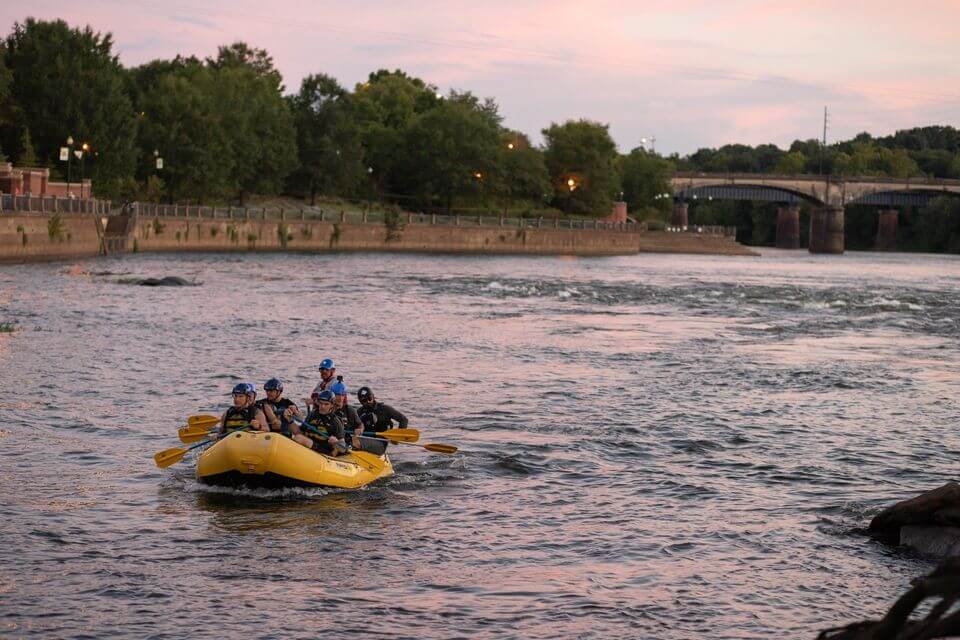Design An Inflatable Product with Vinyl Welding

From a pool raft to a life-saving water rescue device to an inflatable building, vinyl and PVC welding techniques guarantee a waterproof seal and an airtight bond that you can rely on to help save lives or even just give you an air mattress to sleep on. No matter what you need an inflatable fabric construction for, vinyl welding is your best choice.
Learn how to make an inflatable and how vinyl welding plays a vital role in the process by scrolling below.
How To Make Inflatables Into Buildings
Inflatable buildings are a relatively new idea, but they have been around since the industrial revolution. From the first simple, inflatable balloons in the 1700s, by 1900 industrialists were creating inflatable structures such as the Goodyear blimp and inflatable movie theatres.
What Makes Vinyl Welding So Good?
In order to quickly and easily construct inflatables, vinyl welding is the best solution. It’s also waterproof! Use vinyl welding to connect vinyl or PVC together seamlessly. Or, you can fuse vinyl fabric pieces together for durable seams. Vinyl welding is a simpler process than traditional sewing since it eliminates the necessity for a thread.
This is a particularly good option for vinyl inflatables and vinyl-coated fabrics. It can also be used in conjunction with sewing to attach vinyl pieces to other vinyl pieces or fabric.
How Does Vinyl Welding Work?
Vinyl welding is accomplished by using an electric welder and vinyl welding rods, wire, tape or cord. The welder melts the vinyl rod and creates a bond that is heated, making the vinyl pieces stick together.
Vinyl welding is heat-activated and heat-resistant. So, the heat required to complete the welding process is not in itself enough to damage PVC fabrics. When vinyl welding is used to join vinyl fabrics together, the seam is waterproof and airtight. Welded seams are durable and strong, sometimes as strong as a continuous piece of vinyl fabric or PVC material without seams.
Why Is Welding Better Than Stitching?
Vinyl welding has no stitching holes that need to be waterproofed, unlike stitching with waterproof thread. Having fewer holes reduces the risk of leaking seams for inflatable boats and pool toys that require an air-tight seal. Seamless construction makes your watercrafts easier to dry out after use in wet conditions The process of sanding down the rough edges created by melting the rods can also reduce fraying on open-weave fabrics like mesh or tack cloths.
The welding process eliminates the time spent waterproofing holes that would have been sewn. It’s also faster to complete a waterproof welded seam because it doesn’t require an extra step for waterproofing between sewing the seams together. Because there are fewer waterproof seams, watercraft are less likely to develop problems with leaking pockets of air.
The absence of stitching means that you don’t need to do waterproofing maintenance on stitches around the perimeter of your inflatable boat or pool toy. For inflatable boats and pool toys that are made out of multiple different fabrics, vinyl welding can reduce the risk of rips or tears at points where two fabrics meet.
Though it is possible to sew one vinyl material onto another using waterproof thread, vinyl welding is faster. When you use waterproof thread to stitch one vinyl piece onto another — either on the inside or outside of your inflatable boat or pool toy — you have extra waterproofing steps that are also time-consuming.
Why Not Use Adhesives?
Adhesives and glues are commonly used, especially for DIY or homemade waterproofing projects. An industrial sewing provider like Vinyl Technology rarely implements glue, because it’s simply not as reliable as an RF bond or heat seal.
Waterproof adhesives regulate humidity over long periods of time, but they still don’t provide as much protection as waterproof welded seams. Waterproof adhesives aren’t strong enough to hold up against heavy usage, like dragging an inflatable boat across rocks or gravel.
We highly recommend that you use an industrial sewing provider with experience in creating waterproof seams on PVC fabric for your next inflatable project. You’ll be able to trust that your waterproof seams will be waterproof and airtight, without any need for adhesives or glues.
Vinyl Technology is an industrial sewing provider that creates waterproof seams on PVC fabric by using vinyl welding techniques. Vinyl Technology also specializes in creating other products such as self-inflating mattresses, pneumatic pillows, and brown chair cushions with inflatable and vinyl welding.
Welding can allow you to join waterproof fabrics such as vinyl together with a waterproof seam, making your inflatable boat or pool toy successively stronger and more buoyant than one made out of multiple pieces of vinyl fabric sewn together. Our industrial sewing service provides the convenience of waterproof welded seams on PVC fabric, eliminating the need for using adhesives and glues in conjunction with stitching.
How Does Heat Sealing Work?
The most popular instances of a heat weld usually involve PVC or Vinyl fabric. The advantages of heat welding is that it allows for better control over thin materials, is a fast material heating process, and it helps maintain an enhanced seal in both strength and appearance. With vinyl fabric, the advantages offered include fire-retardant properties, oil and chemical resistance, and its high durability and strength.
A company that specializes in industrial sewing, like Vinyl Technology, can help you make inflatables and find the right solution for your vinyl building manufacturing needs.
Related Blogs:
- How is Industrial Sewing Different From Other Kinds of Sewing?
- The Top 5 Uses for a Hazmat Suit
- The Top 4 Industrial Fabric Structures
- What is a Gravity Suit and How Does it Work?
- What is Textile Engineering and How Does it Work?
- Five Things you Didn’t Know About Life Vests
- The Top 3 Military Fabric Uses (That Aren’t Clothes)
- What is Laminated Fabric and How is it Used?

